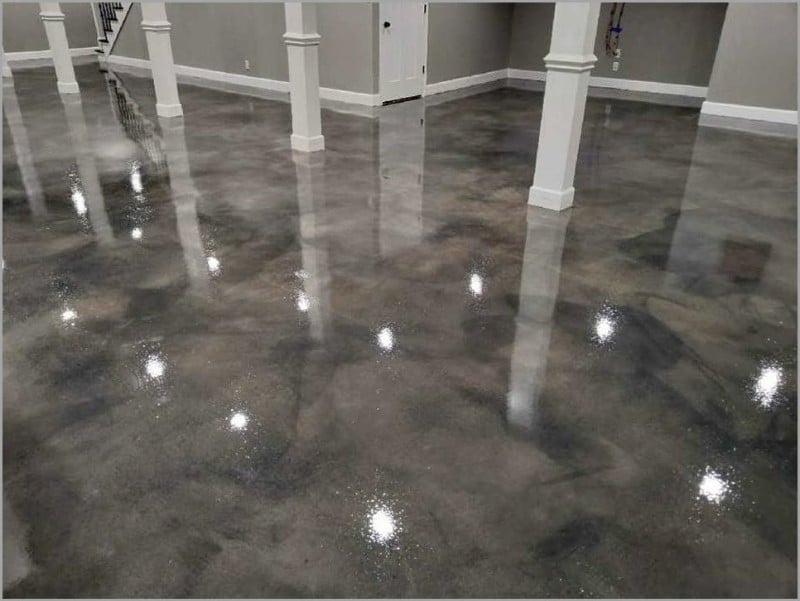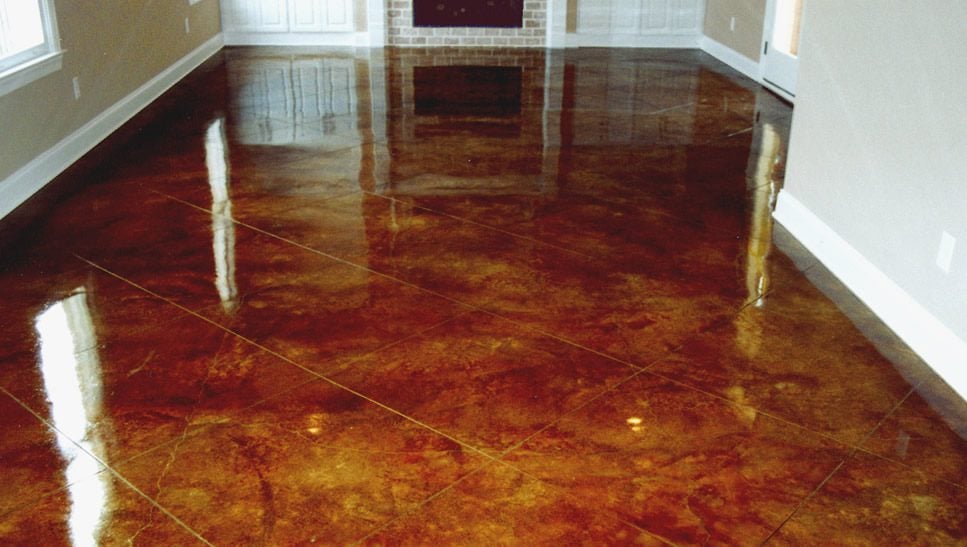Recognizing the Different Kinds of Stained Concrete for Your Next Task
Stained concrete offers different alternatives that satisfy various aesthetic and practical requirements. Each type presents distinctive features that affect the last appearance and resilience of the surface. Comprehending these differences is vital for any person planning a task. From abundant, chain reactions of acid-based stains to the vibrant harmony of solid shade stains, the options can considerably impact the end result. What aspects should one think about when selecting the excellent discolor for their specific demands?
Summary of Stained Concrete
Stained concrete functions as a flexible floor covering choice that can improve the visual charm of various spaces. This technique includes using a coloring representative to the surface of existing concrete, permitting a wide spectrum of design opportunities. Stained concrete is preferred in both household and industrial settings, providing a durable and low-maintenance service that can resemble the look of natural products like stone or ceramic tile.
The discoloration procedure can be performed using water-based or solvent-based items, each offering unique aesthetic effects. The final appearance is affected by factors such as the original concrete surface, the sort of stain made use of, and the application approach. Stained concrete not only enhances interiors and exteriors however additionally promotes sustainability by revitalizing existing concrete frameworks. Consequently, it has gained traction amongst homeowners and developers looking for both performance and style in their flooring options.
Acid-Based Stains: Attributes and Benefits

Unique Shade Variants
Concrete surface areas can change substantially with the application of acid-based stains, which provide an abundant scheme of special shade variants. These stains penetrate the concrete, reacting chemically to produce lively planet tones that range from deep browns and reds to soft eco-friendlies and blues. The resulting hues are commonly variegated, producing an all-natural, marble-like look that improves the concrete's character. Each application yields distinct results because of variants in the concrete's structure and the staining technique utilized, making every job one-of-a-kind. Additionally, acid-based stains can be layered or combined with other techniques to create tailored styles, permitting for individual expression. This convenience makes acid-based stains a prominent option for both residential and commercial applications.
Chain Reaction Described
While numerous elements add to the performance of acid-based stains, the underlying chemical responses play a crucial duty in their special attributes and advantages. These stains mostly include water, acid, and metallic salts. When applied to concrete, the acid reacts with the calcium hydroxide in the cement, creating a chemical makeover that results in long-term color modifications. The metal salts permeate the surface area and bond with the concrete, enabling a variety of shades and tones. This response not only improves aesthetic appeal however likewise gives sturdiness, making the color immune to fading and wear. In addition, acid-based stains can create a variegated finish that simulates natural rock, further boosting their appeal for attractive concrete applications.
Surface Area Preparation Significance
Accomplishing ideal outcomes with acid-based stains depends upon detailed surface preparation. This crucial action warranties that the concrete surface is clean, devoid of pollutants, and correctly profiled for perfect stain absorption. Any type of existing sealants, dirt, or oils can prevent the chain reaction that generates the desired shade and surface, resulting in uneven or patchy outcomes.
Before using the stain, the concrete ought to be mechanically cleaned or pressure washed, adhered to by a detailed assessment for fractures or flaws that may need repair. Furthermore, verifying the surface area is sufficiently dried out will certainly boost stain adherence. By prioritizing these primary steps, the longevity and vibrancy of acid-based stains can be considerably boosted, causing an extra visually pleasing and resilient coating.
Water-Based Stains: Attributes and Benefits

Water-based stains penetrate the concrete, supplying a much more transparent surface that highlights the natural appearance and variations of the surface area beneath. They are offered in a wide array of colors, enabling creative versatility in layout. In addition, water-based stains are much easier to tidy up, requiring only water and soap, which simplifies the application procedure.
Their fast drying time boosts effectiveness, making them a practical option for both do it yourself fanatics and professionals. Generally, water-based stains give an appealing combination of visual convenience and straightforward buildings, making them a preferred alternative for concrete enhancement jobs.
Strong Shade Stains: Vibrant Options for a Bold Look
Solid color stains provide an effective solution for those looking for to produce a vibrant and vivid visual on concrete surface areas. These stains give an uniform coloration that can substantially boost the aesthetic allure of floorings, patio areas, and driveways. Readily available in a broad range of tones, solid color stains enable creative expression, providing to numerous design choices.
Among the vital advantages of solid color stains is their capability to conceal flaws, offering a fresh and polished want to maturing concrete - stained concrete contractors. In addition, their solution typically consists of UV-resistant properties, ensuring long life and shade retention also in harsh weather
Application is straightforward, calling for minimal prep work of the concrete surface. As soon as applied, strong shade stains can be sealed for included security and sheen, more raising their aesthetic quality. With their vibrant options, strong color stains are an outstanding choice for those intending for an impactful and natural style.
Semi-Transparent Stains: Attaining Depth and Measurement
Semi-transparent stains supply an unique approach to boosting concrete surfaces by supplying depth and measurement with various shade options. Understanding the application strategies is necessary for accomplishing the wanted impact, while correct maintenance methods guarantee durability. This section will explore these essential aspects to take full advantage of Check Out Your URL the advantages of semi-transparent discoloration.
Color Options Available
A wide array of shade options exists for semi-transparent stains, enabling property owners and developers to enhance the natural appeal of concrete surface areas. These stains come in a variety of tones, from earthy tones like browns and terracottas to lively shades such as blues and eco-friendlies. The blog here semi-transparent nature of these stains permits the underlying concrete to reveal through, creating a special deepness and measurement that can enhance numerous layout aesthetic appeals. Furthermore, incorporating various shades can generate custom shades, allowing a customized try to find each task. This adaptability makes semi-transparent stains a popular choice for both exterior and interior applications, as they can balance with surrounding components while including aesthetic passion to simple concrete.
Application Strategies Explained
To achieve the desired depth and dimension with semi-transparent stains, correct application strategies are essential. Surface area prep work is vital; the concrete has to be tidy and complimentary of any kind of impurities. This often includes power washing and repairing any splits. Next off, selecting the best applicator, such as a sprayer, roller, or brush, can influence the last look. Sprayers permit a more also application, while rollers can help attain structure. It is necessary to apply the stain in slim, even layers, permitting each layer to completely dry prior to including one more. Manipulating the application technique, such as differing pressure or making use of different tools, can develop special effects. Sealing the stained surface boosts the vibrancy of the colors while providing security.
Maintenance Finest Practices
Regular maintenance is vital for preserving the appeal and honesty of surfaces treated with semi-transparent stains. To preserve these surface areas, regular cleansing is essential. Using a pH-neutral cleaner and a soft-bristle broom will certainly aid remove dirt and debris without damaging the discolor. It is advisable to avoid extreme chemicals, as they can weaken the stain's appearance. Furthermore, routine resealing each to 3 years can shield against wear and fading. This process includes cleaning up the surface area thoroughly and applying a suitable sealer made for stained concrete. House owners need to also keep an eye on for any type of indications of discoloration or damage and address these issues quickly to ensure resilient vibrancy and toughness. Adhering to these best practices will boost the total life-span of semi-transparent stained surface areas.
Results and Methods: Tailoring Your Stained Concrete
Personalizing stained concrete includes a variety of strategies that improve both aesthetics and functionality. Among these methods, layering various tarnish colors can produce deepness and intricacy, permitting one-of-a-kind aesthetic results. Methods such as acid discoloration supply a variegated look, while water-based stains use a much more uniform appearance.
In addition, including attractive patterns, such as stenciling or inscription, can additionally customize the surface, including intricate layouts that deal with specific preferences. Texturing the concrete, whether with stamping or mop surfaces, introduces tactile components that not just boost hold but also boost visual interest.
Using sealants can enhance the shade vibrancy and give defense versus wear. Personalization techniques expand beyond plain color; they can change a conventional concrete piece into a stunning centerpiece, making it suitable for both residential and business spaces. Via careful choice of effects and techniques, stained concrete can attain a really customized appearance.
Upkeep and Long Life of Stained Surfaces
Stained concrete surfaces are understood for their durability and aesthetic allure, keeping their integrity is necessary for ensuring durability. Normal cleansing is vital; sweeping and mopping with view publisher site a pH-neutral cleaner aids protect against dust buildup and staining. In addition, using a sealant every few years can secure the surface area from dampness, chemicals, and UV damage, consequently enhancing its lifespan.
It is also crucial to deal with any splits or chips promptly. Little fixings can reduce additional damage, preserving the visual and structural quality of the surface. For outside stained concrete, seasonal maintenance, such as eliminating snow and ice, is needed to avoid surface area damages from freeze-thaw cycles.
Regularly Asked Questions
Can I Tarnish Existing Concrete Surfaces or Just Brand-new Ones?
The concern of whether existing concrete surfaces can be stained arises regularly. It is undoubtedly possible to stain both brand-new and old concrete, offered the surface is effectively prepared and without contaminants for excellent bond.
The length of time Does the Discoloration Refine Generally Take?
The staining process usually takes one to 3 days, depending on aspects such as surface area preparation, type of discolor, and climate condition. stained concrete. Curing time might prolong past preliminary application, influencing the general duration significantly
Is Stained Concrete Safe for Outdoor Use?
Stained concrete is normally safe for outside use, supplied it is appropriately secured. This sealing secures versus moisture and UV damage, ensuring durability and security, while additionally enhancing the visual allure of outside areas.
Can I Apply Numerous Stain Layers for Various Impacts?
Applying several discolor layers can achieve different results on stained concrete. It is important to assure compatibility between stains and allow appropriate drying out time in between applications to stay clear of unintended reactions or staining.
Exist Any Kind Of Shade Limitations for Stained Concrete?
Color restrictions for stained concrete mostly rely on the sort of stain utilized, with water-based stains using a more comprehensive palette compared to acid-based stains. stained concrete floors. Achieving dynamic shades might call for mindful option and application methods.